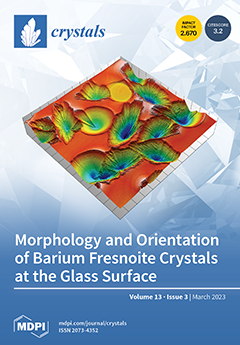Tri-metallic NiMoW catalysts prepared by impregnating mesoporous aluminas (pore sizes of ~9 nm and surface areas of ~225 m
2/g) obtained by sol-gel (NiMoW/Al) and hydrothermal (NiMoW/Al
HYDT) processes were investigated in the hydrodesulfurization (HDS) of thiophene and 4,6-dimethyldibenzothiophene (4,6-DMDBT) at
[...] Read more.
Tri-metallic NiMoW catalysts prepared by impregnating mesoporous aluminas (pore sizes of ~9 nm and surface areas of ~225 m
2/g) obtained by sol-gel (NiMoW/Al) and hydrothermal (NiMoW/Al
HYDT) processes were investigated in the hydrodesulfurization (HDS) of thiophene and 4,6-dimethyldibenzothiophene (4,6-DMDBT) at H
2 pressures of 1 MPa and 5.0 MPa, respectively. The supports and catalysts were characterized by N
2 physisorption, X-ray diffraction (XRD), scanning electron microscopy (SEM), ultraviolet-visible diffuse reflectance spectroscopy (UV-Vis DRS), temperature-programmed reduction (TPR), X-ray photoelectron spectroscopy (XPS), and high-resolution transmission electron microscopy (HRTEM). The NiMoW/Al
HYDT catalyst, which was the most active in both test HDS reactions, was characterized by a pore size of 7.5 nm, whereas the pore size of the catalyst on sol-gel alumina (NiMoW/Al) was only 4.8 nm. Moreover, the NiMoW/Al
HYDT catalyst exhibited reduction peaks shifted to a lower temperature during TPR, indicating weaker metal support interactions, a higher degree of Mo (79%) and W (48%) sulfidation, and an optimal layer slab length distribution of Mo(W)S
2 nanocrystals preferentially between 2–4 nm with an average layer stacking of 1.7 compared to the NiMoW/Al counterpart.
Full article





